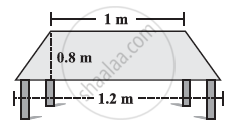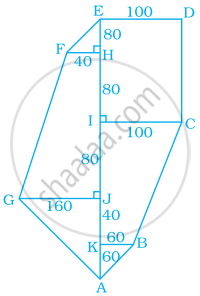Advertisements
Advertisements
Question
Find the area, in square metres, of the trapezium whose bases and altitude is as under:
bases = 12 dm and 20 dm, altitude = 10 dm
Solution
Given:
Bases:
\[12 dm =\frac{12}{10}m = 1.2 m\]
And, 20 dm \[=\frac{20}{10}m=2 m\]
Altitude = 10 dm \[=\frac{10}{10}m = 1 m\]
Area of trapezium \[=\frac{1}{2}\] x (Sum of the bases) x (Altitude)
\[ = \frac{1}{2} \times (1 . 2 + 2) m \times (1) m\]
\[ = 1 . 6 \times m\times m\]
\[ {=1.6 m}^2 \]
APPEARS IN
RELATED QUESTIONS
The shape of the top surface of a table is a trapezium. Find its area if its parallel sides are 1 m and 1.2 m and perpendicular distance between them is 0.8 m.

The area of a trapezium is 91 cm2 and its height is 7 cm. If one of the parallel sides is longer than the other by 8 cm, find the two parallel sides.
The area of a trapezium is 384 cm2. Its parallel sides are in the ratio 3 : 5 and the perpendicular distance between them is 12 cm. Find the length of each one of the parallel sides.
The area of a trapezium is 1586 cm2 and the distance between the parallel sides is 26 cm. If one of the parallel sides is 38 cm, find the other.
The following figure shows the cross-section ABCD of a swimming pool which is a trapezium in shape.

If the width DC, of the swimming pool, is 6.4 m, depth (AD) at the shallow end is 80 cm and depth (BC) at the deepest end is 2.4 m, find its area of the cross-section.
Find the missing values.
| Height 'h' | Parallel side 'a` | Parallel side 'b` | Area |
| 16 cm | 15 cm | 360 sq.cm |
In a trapezium if the sum of the parallel sides is 10 cm and the area is 140 sq.cm, then the height is
When the non-parallel sides of a trapezium are equal then it is known as
The table top is in the shape of a trapezium with measurements given in the figure. Find the cost of the glass used to cover the table at the rate of ₹ 6 per 10 sq.cm
Find the area of the following fields. All dimensions are in metres.

